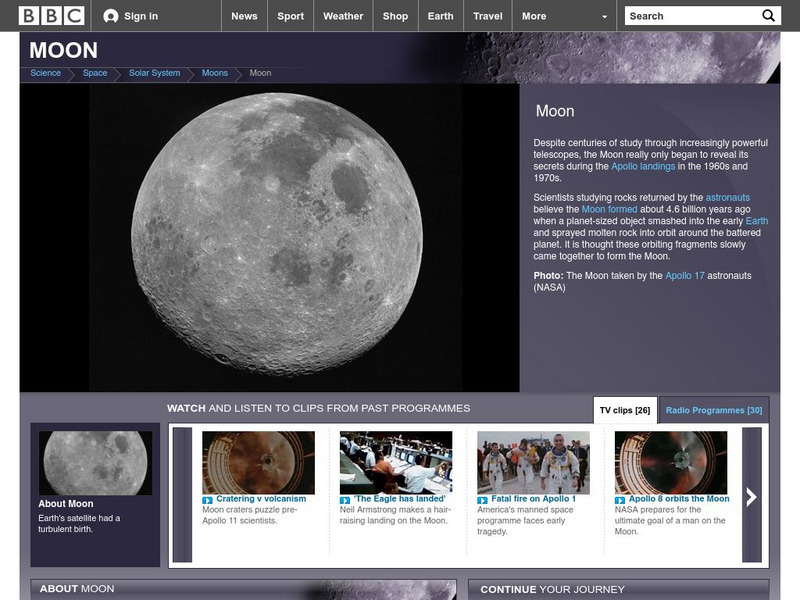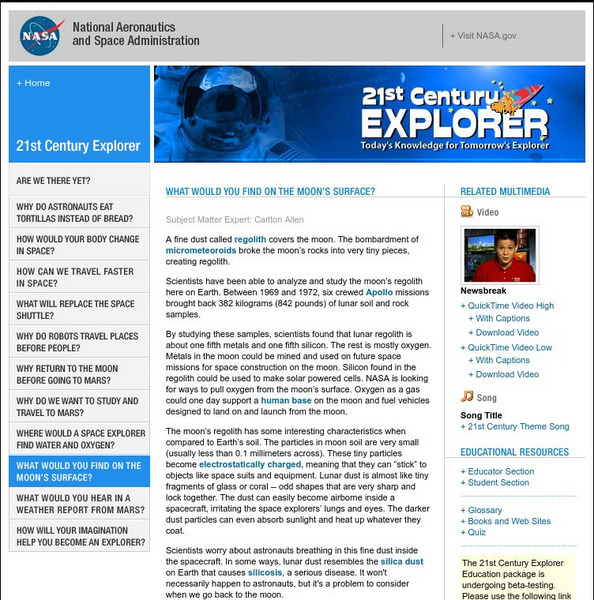Curated OER
Day and Night
Young scholars discuss why day and night occur after visualizing a teacher-led demonstration.
Curated OER
How Distant Is The Moon?
Students discover how Aristarchus, a Greek astronomer around 230 BC, used a simple observation of the eclipse of the Moon, plus clever reasoning, to deduce the distance of the Moon. They practice the same calculation technique.
Curated OER
Lunar Life Support
Students design and build models of nine life support systems which are crucial to our successful settlement of the Moon. Each team must define the requirements of their system, exploring how these requirements are currently being met on...
BBC
Bbc Science and Nature: The Moon
The BBC brings together a lot of useful information about the moon and related topics, such as the lunar landings, and publishes it in the form of a traveler's guide.
NASA
Nasa: 21st Century Explorer: What Would You Find on the Moon's Surface?
This article explains regolith on the moon: what it is, what it's made of, and how scientists could use it in future moon expeditions.
Other
Lunar and Planetary Institute: Ranger Photographs of the Moon
Lunar atlas containing selected Ranger mission photographs and documentation.
Utah Education Network
Uen: Lunar Language
This instructional activity engages students in listening and viewing comprehension strategies to help them learn about the phases of the moon. Students will use a specialized graphic organizer to draw and describe observed moon phases....
Better Lesson
Better Lesson: Our Stars
In this lesson, students will observe and communicate how the stars are in the sky both day and night. The extremely detailed lesson includes photos and videos of the lesson in actions, examples of student's work, materials, parent...
NASA
Nasa: Welcome to From Earth to the Solar System (Fettss)
A collection of high-resolution images of space. Images "showcase the discoveries and excitement of planetary exploration, with a focus on the origin and evolution of the Solar System and the search for life".
Sophia Learning
Sophia: Eclipses
A introductory lesson explaining the differences between lunar and solar eclipses.
NC State University
Ncsu.edu: Adventures of the Agronauts
This site is an online science curriculum on how to grow plants on the Moon. There are six lessons that have a glossary also included. There are movies that demonstrate concepts, and teacher resources. The sites topics cover, the Earth,...
NASA
Nasa: Jupiter: Moons: Elara
Statistics and general information about the thirteenth moon of Jupiter. One statement sums it up: "Very little is known about Elara."
Ducksters
Ducksters: Earth Science for Kids: Ocean Tides
Did you know the rising and falling of the sea level is caused by the gravity of the Moon and the Sun? Kids learn about ocean tides including tidal currents and types of tides on this site.
Curated OER
Eyes on the Sky, Feet on the Ground: The Earth's Moon
In this online textbook produced by the Smithsonian, students explore the phases of the moon, the moon's orbit, the origin of the moon, and the tides. Includes numerous inquiry-based activities.













